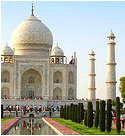








"Not a piece of architecture, as other buildings are, but the proud passions of an emperor’s love wrought in living stones !!"
-Sir Edwin Arnold, English Poet
Taj Mahal, situated on the bank of river Yamuna in Agra, is considered the finest example of Mughal architecture. It is the most well preserved and architecturally beautiful tomb in the world. Built in pure white marble, the Taj is among the seven wonders of the world. Taj Mahal is a tribute to queen Mumtaz Mahal and a token of love from the Mughal emperor Shah Jahan. It was designed by an Iranian architect and the overall monument was completed in a duration of 22 long years (1631-1653).
Background
When Mumtaz Mahal or Arjumand Bano Begum, died in 1631 while giving birth to her 14th child, emperor Shah Jahan made a promise to build the world's most beautiful monument in her memory. Therefore, he made the Taj Mahal and the queen's body was enshrined in the crypt of the main tomb of the Taj or “Crown Palace”. Shah Jahan was later overthrown by his son Aurangzeb. After Shah Jahan's death, his son Aurangzeb buried his body near the grave of his beloved wife. During the empire of East India Company in India, the British chiseled out precious stones and gems from the walls of the Taj Mahal.
Architecture
The emperor hired around twenty thousand people to work on it and the material (marble, sand, cement etc.) was brought in from all over India and central Asia. More than 1000 elephants were used to transport the material to Agra, the main site. The entire monument of the Taj Mahal comprises of five sections, Darwaza (The main gateway), Bageecha (The gardens), Masjid (The mosque), Naqqar Khana (The rest house) and Rauza (The main mausoleum). The Mughal style of construction is a perfect blend of Persian, Turkish, Indian and Islamic architectural styles. During its construction, the country was under the Mughal rule. So, the emperor brought the translucent white marble from Rajasthan, jasper from Punjab, jade and crystal from China, the turquoise from Tibet and the Lapis lazuli from Afghanistan. He also used sapphire and carnelian, imported from Sri Lanka and Arabia respectively. A total of twenty eight different kinds of stones were fitted in the white marble monument.
How The Taj Is Different From Other Monuments
Spread over 42 acres of land, the Taj Mahal is made on a wooden base, which has a unique quality of getting stronger & harder on being dipped in water.
According to a myth, the emperor cut off the hands of all the workers after the Taj was completed, because he did not want any other building or monument to be constructed as beautifully as the Taj Mahal. When the emperor ordered to cut the hands of the head architect, he asked for five minutes from the emperor to finish some task on the roof of the tomb. The architect went to the roof and made a tiny hole somewhere, which nobody has been able to detect till date. That is why everytime it rains, droplets fall on the graves of the emperor and the queen, but nobody knows where the water droplets come from.
All these qualities make the Taj a unique monument and one of the seven wonders of the world. Around four million people visit this place annually, out of which two millions (approximately) are from overseas. |
||
 |
||
NORTH EAST INDIA TOURS
SOUTH INDIA TOURS CENTRAL INDIA TOURS |
NORTH INDIA TOURS
WEST INDIA TOURS |
|
 |
||
BATTLEFIELD TOURS PILGRIMAGE TOURS TRIBAL TOURS |
CULTURAL TOURS
ADVENTURE TOURS WILDLIFE TOURS |
|
 |
||
7 Days tours 10 - 15 days tours |
7 - 10 days tours more than 15 days tours |
|

Copyright © 2020, www.indiatourpackagesnet.com
